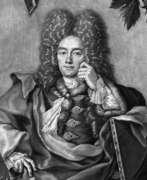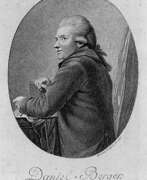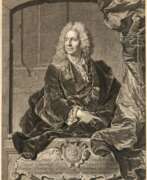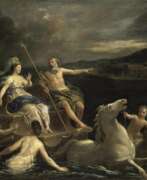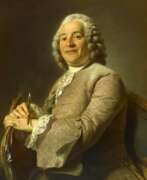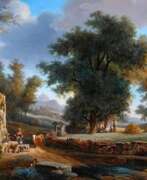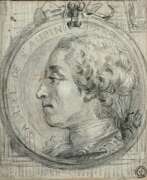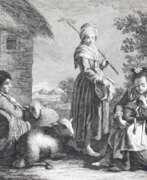Engravers 18th century


Antonio Capellan was an Italian engraver, active in a Neoclassical style. He trained with Joseph Wagner. Capellan is best known for making engraved copies of masterworks of the Italian Renaissance found in private collections, which were published in Gavin Hamilton's work, Schola Italica Picturae. He also engraved a series of portraits of cardinals titled "Calcographia R.C.A. apud Pedem Marmoreum". In 1759, he engraved portraits of Michelangelo and Giorgio Vasari for a volume of the life of Vasari, curated by Bottari.


Jean-François Albanis Beaumont was a French landscape painter, engineer, traveler and geographer.
He studied engineering in Paris and worked on architectural structures at Chambérly. Beaumont later accompanied the Duke of Gloucester, William Frederick of Hanover on a grand tour of Germany, Italy, France, and Switzerland, making notes and detailed pictorial sketches of views along the way. In 1800 he published the illustrated books Journey to the Lepontine Alps from France to Italy and Description of the Grecian and Cottian Alps (1802 and 1806).


William Alexander was a British painter, illustrator and printmaker.
He studied painting at the Royal Academy and became a very famous artist. In 1792-1794 he accompanied the official embassy to Peking of Lord George Macartney on behalf of the British government, where he documented the visit and made many drawings of the Chinese court. These depict various mandarins, merchants, members of the royal family and members of Chinese society. In 1805, William Alexander published Costume of China, an album illustrated with 48 color prints, which was a success with the public.


Samuel Alken the Elder was a British painter, printmaker and illustrator.
Samuel Alken studied at the Royal Academy School in London. In 1779 he published A New Book of Ornaments Designed and Engraved by Samuel Alken, and later established himself as one of the most distinguished engravers in the new technique of aquatint. Alken produced magnificent compositions of the British countryside, including moonlit night scenes. His works include engravings by George Morland, Richard Wilson, Thomas Rowlandson, and Francis Wheatley. In 1796 his plates of sixteen views of the lakes of Cumberland and Westmorland, after drawings by John Ames and John Smith, were published, and in 1798 a set of aquatint views of North Wales after drawings by the Rev. Brian Broughton.
His sons, Samuel Alken the Younger (1784-1824), Henry Thomas Alken (1785-1851) and Samuel Henry Alken (1810-1894) also became artists.


Francesco Faraone Aquila was an Italian engraver. In 1690 he moved to Rome where his brother Pietro had been an engraver for several decades in major workshops in the capital. Pope Clement XI gave him an order which has remained his main work - engraving the bas-reliefs of the Antoninus Pius column and its pedestal. Another important work by Francesco Aquila is the engraving of the frescoes of the dome of the Cathedral of Parma by Correggio and the painting of the Vatican chambers. Following the antique taste established in the 18th century, Aquila engraved various Roman classical works: statues, vases and triumphal arches, thus satisfying the demand of mainly foreign visitors, mainly German and English. His portraits of his contemporaries, both painters and clergymen, also enjoyed great popularity.
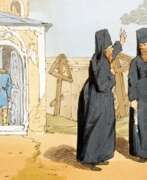

John Augustus Atkinson was a British watercolorist, illustrator and engraver.
In 1784, the young Atkinson traveled to St. Petersburg, Russia, to stay with his uncle James Walker, who worked as an engraver at the court of Empress Catherine the Great. The aspiring artist learned from the work of the great Russian painters whose paintings he saw in the art galleries of St. Petersburg. Catherine and her son Paul I, noticing his talent, commissioned Atkinson to paint pictures on historical subjects.
In 1801 Atkinson returned to England and a year later published an album entitled "Pictorial representation of Russian manners, customs and amusements" on 100 plates drawn and engraved by himself. This work was a great success in Europe. Later, during the Napoleonic Wars, Atkinson created many battle scenes, including the Battle of Waterloo and naval battles. In 1808 he was elected to the Society of Watercolor Painters.


Carl Daniel David Friedrich Bach was a German artist of the late eighteenth and early nineteenth centuries, the Baroque period. He is known as a painter, graphic artist and printmaker.
Bach worked in the historical genre, was a portraitist, animalist, created canvases on allegorical subjects in the spirit of his era. In his works he combined elements of baroque and classicism. The artist often worked in the etching needle technique.


Elias Baeck called "Heldenmuth", was a German painter and engraver from Augsburg. Baeck worked for some time in Rome, then in Laybach, but finally returned to Augsburg, where he died in 1747. His chief works — both in painting and engraving — were portraits and landscapes. His engravings are sometimes signed "E.B.a.H.", standing for "Elias Baeck, alias Heldenmuth".


William Baillie was a British artist who lived and worked in India in the late 18th century.
He went to India in 1777 as a cadet in the Bengal Infantry and remained there for the rest of his life. After retiring, he published a newspaper in Calcutta, painted landscapes with views of the city and surrounding countryside, made engravings, and made topographical maps. In 1794, William Baillie published a set of hand-colored aquatints entitled Twelve Views of Calcutta.


Ludolf Bakhuizen was a Dutch painter of the 17th and early 18th centuries. He is known as an outstanding master of seascapes. Bakhuizen also painted biblical themes and portraits of his contemporaries as well as engravings and miniature models of ships.
Ludolf Bakhuizen is considered one of the best marine painters of the Golden Age of Dutch painting. Among the admirers of his work were many influential European rulers, including the Russian Tsar Peter the Great. The master met Peter I, who visited Amsterdam in the mid-1690s and, according to contemporaries, even managed to give some painting lessons to the Russian tsar. In addition, Вakhuizen made models of all kinds of ship designs on commission from Peter the Great.
Toward the end of his life, the Amsterdam authorities honored Bakhuizen by opening his own gallery on the top floor of the City Hall for his achievements in the fine arts. The best masterpieces of his work are now preserved in museums in the Netherlands, Germany, England, France, and Italy.
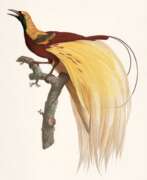

Jacques Barraband was a French zoological and botanical illustrator, renowned for his lifelike renderings of tropical birds. His pictures were based on mounted specimens and his illustration was considered the most accurate ones made during the early 1800s.


Johann Wolfgang Baumgartner was an Austrian-German Rococo painter.
He worked as a glass painter. The ceiling painting in the Sanctuary of the Holy Cross of the former Klosters Mountains is considered as his largest and most important work.
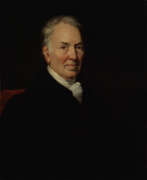

Thomas Bewick was an English wood-engraver and natural history author. Early in his career he took on all kinds of work such as engraving cutlery, making the wood blocks for advertisements, and illustrating children's books. He gradually turned to illustrating, writing and publishing his own books, gaining an adult audience for the fine illustrations in A History of Quadrupeds.
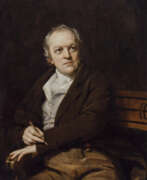

William Blake was an English poet, painter, and printmaker. Largely unrecognised during his life, Blake is now considered a seminal figure in the history of the poetry and visual art of the Romantic Age. What he called his "prophetic works" were said by 20th-century critic Northrop Frye to form "what is in proportion to its merits the least read body of poetry in the English language". His visual artistry led 21st-century critic Jonathan Jones to proclaim him "far and away the greatest artist Britain has ever produced". In 2002, Blake was placed at number 38 in the BBC's poll of the 100 Greatest Britons. While he lived in London his entire life, except for three years spent in Felpham, he produced a diverse and symbolically rich collection of works, which embraced the imagination as "the body of God" or "human existence itself".
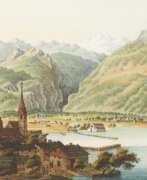

Johann Heinrich Bleuler the Elder was a Swiss landscape painter and engraver.
Bleuler the Elder first trained as a porcelain painter at the Kilchberg-Schooren porcelain manufactory near Zurich. In the early 1780s he settled in Feuertalen and became the founder of the dynasty of artists that is known as the "Bleulerische Malschule". His two sons, Johann Heinrich Bleuler the Younger (1787-1857) and Johann Ludwig Bleuler (1792-1850), also became artists and continued their father's work. And in total, there were up to 25 artists in the dynasty, including godchildren and other relatives.
Bleuler the Elder created mainly landscapes of the Rhine, painted in gouache and watercolor, panoramic views of Swiss cities. He also worked as an art teacher.


Louis-Marin Bonnet (French: Louis-Marin Bonnet) is a French draftsman and engraver, an outstanding master of metal engraving using the “pencil style” technique. Since 1757, Louis-Marais Bonnet was a student of Jean-Charles Francois, then of Gilles Demarteau. He became famous for his color engravings reproducing drawings by A. Watteau, F. Boucher, Sh.-A. Van Loo, J.-B. Yue. Bonnet reproduced mainly complex pastel drawings, using up to eighty boards per engraving. He used opaque paints that gave a matte tone and tinted paper. He reproduced the spaces by printing with white from a separate board. Bonnet even imitated the golden frames bordering the original drawings. This technique is called “pastel style”. In 1769, Bonnet described his technique in detail in the book Pastel in Engraving, Invented and Executed by Louis Bonnet. In 1765-1767, the French master worked in St. Petersburg, where he completed several engraving portraits in the “pencil style” of Catherine II and the heir Pavel Petrovich based on drawings by Jean-Louis de Velli, then returned to Paris and opened his own workshop.


François Boucher, a French artist, is celebrated for his significant contributions to the Rococo style of painting. His works are renowned for their idyllic and voluptuous themes, which include classical subjects, decorative allegories, and pastoral scenes. Boucher's talent in creating intricate and charming paintings made him a favorite in the French court, especially with Madame de Pompadour.
François Boucher's skills were not confined to painting alone; he was also an adept draftsman and tapestry designer. His designs for the Beauvais tapestry workshops were highly successful, influencing decorative arts across Europe. Moreover, Boucher's influence extended to porcelain, with his designs being replicated on tableware and decorative pieces at the Vincennes and Sèvres factories.
Despite the later criticism of his style as overly frivolous and disconnected from the emerging Neoclassical trends, François Boucher's works continue to be admired for their aesthetic beauty and historical significance. His ability to blend various elements into a cohesive and appealing visual narrative demonstrates his mastery and enduring legacy in the art world.
For art collectors and enthusiasts, François Boucher's oeuvre offers a fascinating glimpse into 18th-century French art and culture, reflecting the opulence and delicate tastes of the Rococo period. His paintings and designs continue to be celebrated and studied for their artistic merit and historical context.
To stay updated on the latest exhibitions, sales, and events related to François Boucher's works, consider subscribing to updates from reliable art and antique sources. This way, you'll remain informed about opportunities to engage with the art of one of Rococo's most distinguished masters.
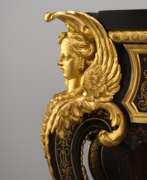

André-Charles Boulle, a French artist and cabinetmaker, was celebrated for his mastery in marquetry, a decorative technique involving inlaid veneers of wood, metal, and tortoiseshell. Born in Paris in 1642, Boulle's work defined luxury and sophistication in 17th and 18th-century French furniture, earning him the title of "Premier ébéniste du Roi" under Louis XIV. His contributions to art and culture extend beyond mere craftsmanship, embodying the opulence of the Louis XIV style and influencing European decorative arts profoundly.
Boulle's innovative techniques, particularly his unique use of marquetry, known as "Boulle work," involved intricate patterns of brass, pewter, and tortoiseshell, setting new standards for furniture design. This approach allowed him to create stunning visual effects, with his creations including clocks, cabinets, and tables that showcased both artistic flair and technical brilliance. His work, characterized by elaborate motifs and an exceptional blend of materials, is regarded as the epitome of Baroque artistry, blending sculpture, painting, and architecture into functional objects of beauty.
Several of Boulle's masterpieces are preserved in prestigious museums, such as the Louvre and the Palace of Versailles, where they continue to captivate visitors with their intricate details and historical significance. Notable works attributed to him, like the intricate coffers on stands and monumental cabinets housed in the J. Paul Getty Museum, reflect his role as a "painter in wood," celebrating French military victories and the grandeur of the Sun King's court. These pieces, never signed but attributed to him based on stylistic elements and historical records, highlight Boulle's innovative use of materials and his impact on the decorative arts.
For collectors and experts in art and antiques, André-Charles Boulle's work represents the zenith of French decorative arts. His legacy is not only in the beauty of his creations but also in the techniques he perfected, which continue to inspire contemporary designers and craftsmen. Those interested in the elegance and history of Boulle's work are encouraged to sign up for updates on new product sales and auction events related to this iconic artist. This subscription offers a unique opportunity to connect with the world of André-Charles Boulle, ensuring enthusiasts are informed of the latest discoveries and offerings that celebrate his enduring influence on culture, art, and design.


Johann Christian Brand was an Austrian landscape painter and graphic artist, copperplate etcher.
He received his first lessons in painting from his father, the landscape painter Christian Hilfgott Brand (1695-1750), then studied at the Vienna Academy of Painting. In 1758 Brand was commissioned by the imperial family for a series of hunting scenes. In addition to many landscapes, he also created 16 oil paintings for Vienna's Museum of Military History, depicting various types of cavalry of the Austrian army during the reign of Empress Maria Theresa.
From 1772 Brand was professor of painting at the Vienna Academy.


Richard Brompton was an esteemed English portrait painter, active during the mid to late 18th century. Born around 1734, Brompton honed his artistic skills under the mentorship of Benjamin Wilson and later, in Italy, with Raphael Mengs. His Italian sojourn also brought him under the patronage of the Earl of Northampton, leading to significant exposure and subsequent recognition back in England.
Brompton's mastery in portraiture gained him high-profile commissions and admittance to elite art circles, including the Presidency of the Society of Artists from 1779 to 1780. Some of his notable works include portraits of influential figures such as William Pitt, the 1st Earl of Chatham, and Admiral Sir Charles Saunders, which are preserved in prestigious locations like the National Maritime Museum and the National Portrait Gallery.
Later in his career, financial difficulties led him to St. Petersburg, Russia, where he served as the court painter to the Empress of Russia, enjoying considerable success before his death in 1783.
For those interested in the works and legacy of Richard Brompton, especially collectors and art experts, staying informed about upcoming auctions and exhibitions can be highly rewarding. To receive updates specifically about new product sales and auction events related to Richard Brompton, consider signing up. This subscription ensures you are well-informed of opportunities to acquire pieces linked to this distinguished artist.


Canaletto, born Giovanni Antonio Canal, was an illustrious Italian painter celebrated for his masterful cityscapes, particularly of Venice and London. Emerging as a topographical painter after 1719, Canaletto became renowned for his detailed and atmospheric views, known as vedute, which captured the essence of Venice and London with a unique blend of accuracy and artistic embellishment. Despite using a camera obscura to achieve precision in his architectural details, Canaletto often infused his paintings with creative adjustments to enhance their appeal.
His early works, such as "The Stonemason's Yard," are particularly prized for their vivid portrayal of Venice's daily life and architectural beauty. Canaletto's paintings were highly sought after by English aristocrats during their Grand Tours, leading him to spend a significant period in England, where he continued to produce esteemed works capturing the English landscape and urban scenes.
Despite his international success, Canaletto's work was less appreciated in his native Venice during his lifetime, only gaining broader recognition and appreciation in later years. His legacy, however, has had a lasting impact on landscape painting, influencing future generations of artists.
If you're interested in staying updated on art exhibitions and auctions featuring Canaletto's work, consider signing up for newsletters from art galleries or auction houses that specialize in historical artworks. This way, you'll be informed about new sales and exhibition events related to Canaletto without any exaggerated language or promises.


Luca Carlevarijs was an Italian painter and engraver working mainly in Venice. He pioneered the genre of the cityscapes (vedute) of Venice, a genre that was later widely followed by artists such as Canaletto and Francesco Guardi.


Luca Carlevaris was an Italian painter and engraver working mainly in Venice. He pioneered the genre of the cityscapes (vedute) of Venice, a genre that was later widely followed by artists such as Canaletto and Francesco Guardi.


Pieter Casteels III was a Flemish painter, engraver and designer, a member of the Guild of St. Luke in Antwerp.
He was born into the family of the painter Pieter Casteels II or the Younger (1673-1701), who gave his son his first lessons in painting. In 1708 Peter went to London, where he became active in the London art community and a member of the Rose and Crown Club.
Casteells successfully painted numerous floral still lifes with exotic birds, which were favored by the nobility of the time, as well as idyllic scenes with domestic birds and animals. His works were also often used as decorations for fireplaces and doors. The great success of this genre led the artist to publish the Twelve Months of Flowers and Twelve Months of Fruit series - these prints served as models for workers in textiles and other luxury industries.
In 1735 Peter Casteells III retired from painting and turned his attention to textile design, working for the rest of his life for textile manufacturers in Surrey and then London.
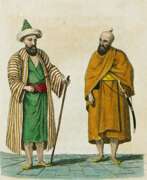

Antoine-Laurent Castellan was a French painter, engraver and architect.
Castellan traveled to Turkey, Greece, Italy and Switzerland. He was the official artist of the mission of Engineer Ferrego to the court of Sultan Selim III, spending several months in Constantinople in 1797. Castellan was a prolific draughtsman, making notes of everything he saw in Constantinople, and also engaged in portrait painting of socialites, which he captured in numerous works he published on his return to France. His best-known work is The Manners, Customs and Costumes of the Otomans and a Brief Account of their History, published in 1812.


Jacob Cats was a Dutch painter, printmaker and graphic artist.
He was famous for his urban landscapes and landscapes with realistic portrayals of people and animals. His works were distinguished for their originality, poetic rendering of the features of nature and depth.
His works are represented in almost all major public collections in the Netherlands.




John Heaviside Clark was a Scottish battle painter, marinist and printmaker.
Clark is best known for his aquatint engravings depicting Scottish towns, historically important for their precise attention to detail and concise clear depiction of space. He earned the nickname Waterloo Clark for his sketches of the battlefield of Waterloo, later published as color engravings.
John Clark is the author of A Practical Essay on the Art of Coloring and Drawing Landscapes with Illustrations, published in 1807, and A Practical Illustration of Gilpin's Day, with thirty color plates based on monochrome studies representing different times of day.
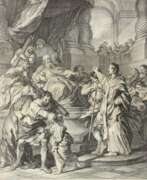

Charles-Nicolas Cochin the Elder was a French painter and line engraver.
Charles-Nicolas Cochin the Elder painted until the age of twenty-two, and then devoted himself entirely to engraving. In 1731 he became an academician, and on the occasion of his reception engraved portraits of Jacques Sarracen and Estache Le Sueur. He then turned his attention to the fanciful subjects of Watteau, Lancret, and Chardin, after which he executed several fine works.


Charles-Nicolas Cochin was a French engraver, designer, writer, and art critic. To distinguish him from his father of the same name, he is variously called Charles-Nicolas Cochin the Younger, Charles-Nicolas Cochin the son, or Charles-Nicolas Cochin II.
More than fifteen hundred works by Cochin can be identified. They include historical subjects, book illustrations, and portraits in pencil and crayon. The richest collection of his engravings, apparently selected by himself, is in the Royal Library, now part of the Bibliothèque nationale.


Antoine Coypel was a French painter, known for his versatile and eclectic style, which blended the French classical tradition with influences from Pieter Paul Rubens and the Roman Baroque. His career flourished thanks to his role as a court painter and his positions within the French art world, including his tenure as a professor and director at the Académie Royale.
Antoine Coypel's artistry was evident in his ability to infuse classical subjects with a vibrant color palette and dynamic compositions, reflecting a transition in French painting towards a lighter 18th-century style. His notable works include "Democritus" at the Louvre and "Susan accused of adultery" at the Museo del Prado, demonstrating his range from philosophical figures to biblical narratives. Beyond painting, Coypel was also a master draughtsman, with many of his drawings preserved at the Louvre, showcasing his skill in figure studies and preparatory sketches.
Antoine Coypel's legacy extends through his family, with his son Charles-Antoine and half-brother Noël-Nicolas also being recognized painters. His works are held in esteemed collections globally, from the Louvre in Paris to the Metropolitan Museum of Art in New York, and continue to be celebrated for their artistic merit and historical significance.
For collectors and art experts, understanding Antoine Coypel's contributions provides valuable insights into the evolution of French art and the interplay between classical influences and personal creativity.
If you're interested in staying informed about upcoming sales and auction events related to Antoine Coypel's works, sign up for updates to ensure you don't miss out on these exclusive opportunities.


Giuseppe Maria Crespi, an Italian Baroque painter from Bologna, was known for his unique contributions to genre painting, capturing scenes of everyday life with a distinct realism and humanism. His work diverged from the formal academic tradition, providing a more direct and immediate approach to his subjects. Crespi's artistry is evident in his kitchen scenes and domestic subjects, where he depicted the grittier aspects of daily life, often with a touch of darkness or irony, as seen in his paintings like "The Flea" and "Searching for Fleas".
Giuseppe Maria Crespi's style evolved through his studies, first with Angelo Michele Toni and then with more prominent artists like Domenico Maria Canuti and Carlo Cignani. He was particularly influenced by the Venetian color and brushwork, integrating these into his own Bolognese tradition, which he further enriched during his travels across Italy.
His contributions extended beyond his own works; Giuseppe Maria Crespi influenced a new generation of artists, including notable Venetians like Giovanni Battista Piazzetta and Pietro Longhi, and his sons Antonio and Luigi Crespi followed in his artistic footsteps.
For art collectors and enthusiasts, Giuseppe Maria Crespi's works offer a unique glimpse into the Baroque era's daily life, marked by his distinctive style and profound humanism. If you're interested in exploring more about Crespi's art and staying updated on related sales and auction events, consider subscribing for updates, ensuring a connection to this remarkable artist's legacy.


Joseph Wilhelm Eduard d'Alton was a German engraver, naturalist and educator.
He had an initial military education and later studied art and natural history while traveling in Italy and France. Eduard d'Alton is widely known for his anatomical and zoological engravings and etchings. In 1818, d'Alton was appointed professor of natural history at the University of Bonn, where he later began to teach art history as well. Among his students was Karl Marx.
D'Alton's son Johann Samuel Eduard d'Alton (1803-1854), professor of anatomy, continued his father's unfinished Osteologie (Bonn, 1827-1838) and published the first volume of the Handbook of Comparative Human Anatomy.


Marc'Antonio Dal Re was an Italian painter, engraver and publisher.
Dal Re is the author of a work entitled Ville di delizia, consisting of six volumes and published in 1743. It is an illustrated description of numerous noblemen's luxurious villas in the neighborhood of Milan. Dozens of engravings are accompanied by accurate descriptions of the palaces, written personally by Dal Re.


Michel François Damame Demartrais was a French artist, painter and engraver.
He created such famous works as The Complete Collection of Various Gardens and Viewpoints of the Imperial Houses of Russia (1811) and Paris and its Environs (1818). Damame visited and worked in Russia from 1792 to 1805. Returning to Paris, he published several albums in the 1810s with locations of St. Petersburg and other cities, including Novgorod, as well as highly detailed genre scenes and depictions of the costumes and customs of the inhabitants of Russia.


Justus Danckerts I was a Dutch engraver and print publisher who along with other members of the Danckerts family created one of the leading Dutch geographical map and atlas publishing houses. Justus Danckerts was the son of Cornelis Danckerts I (1603-1656), who established the Danckerts cartographic family business in Amsterdam. After producing in the early 1680s over 20 folio-sized atlas maps, he published in 1686-1887 the first Danckerts atlas. In 1690, another 26-sheet geographical atlas was published; between 1698 and 1700, a 60-sheet atlas was completed. Its map sheets and plates were used by various publishers until the middle of the 18th century.


William Daniell was a British landscape painter, marinist and aquatint printmaker, and a Royal Academician.
In his youth he traveled extensively in India with his uncle, the landscape painter Thomas Daniell (1749-1840), with whom he later worked on one of the best illustrated works of the time, Oriental Landscapes. In addition to sketches, William Daniell's diaries contain detailed and insightful descriptions of his travels in North and South India, which formed the basis of their subsequent publications and helped to shape a coherent British view of India.
Daniell was also a prolific engraver and produced countless illustrations for historical and travel works and volumes on the natural world. One of his most famous works was Journey Round Britain (4 volumes, 1814-1825).
William Daniell's work was exhibited at the Royal Academy and the British Institution, and he became a Royal Academician in 1822.
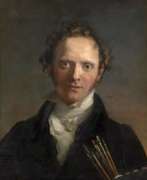

George Dawe was an English portrait artist, celebrated for his depictions of Russian military leaders. Born in 1781 in London, Dawe was a prodigy in engraving under his father's tutelage before shifting his focus to painting. He gained recognition at the Royal Academy of Arts and became a member in 1814.
Dawe's career reached international prominence when he moved to Saint Petersburg in 1819, following a commission from Tsar Alexander I. There, he created over 300 portraits for the Military Gallery at the Winter Palace, capturing the visages of Russia's elite during Napoleon's invasion. His works, praised for their historical value and artistic merit, are still displayed in the Hermitage Museum today.
Despite his death in 1829, Dawe's legacy persists, particularly in Russia, where he is regarded as a key figure in military portraiture. His works remain a significant part of cultural exhibitions and continue to attract scholars and art enthusiasts.
If you're fascinated by the rich history of art and the stories behind iconic portraits, consider signing up for updates on George Dawe. Stay informed about new sales and auction events that feature his masterful works. Your subscription will keep you connected to the world of historical art and its vibrant market.


Adam Friedel or Adam Friedel von Friedelsburg was a Danish soldier and pirate, painter and actor.
Having the character of an adventurer, Friedel became a participant in the War of Liberation in Greece 1821-1829. He was granted the title of Baron Friedel von Friedelsburg, but the information about his aristocratic origin was found to be false and he was expelled from the Greek army. He was eventually forced to leave Greece for London, where his talents as an actor, musician, and painter became apparent.
In London, Adam Friedel opened his own lithographic studio. He became best known for his portraits of the heroes and leaders of the Greek Revolution, first produced between 1824 and 1826. The series of 24 portraits sold in large editions throughout Europe. He also created several famous portraits of Lord Byron.


Romeyn de Hooghe was a Dutch painter, sculptor, engraver and caricaturist of the late Baroque period, writer and philosopher.
Hooghe became famous for his political caricatures of King Louis XIV of France and propaganda pamphlets in support of William of Orange. He portrayed the war against the French monarch and his allies as a struggle between freedom and religious despotism.
Romeyn de Hooghe was a superb engraver and created over 3,500 engravings during his lifetime. His most important work is Hieroglyphica of Merkbeelden der oude volkeren (Hieroglyphics or Symbols of the Ancient Peoples), where he appeared not only as a consummate master of engraving, but also as a historian, talented writer and philosopher. This book has long been regarded in Europe as one of the most authoritative sources on classical mythology. It contains 64 engravings illustrating all stages of the narrative of myths, ancient cults and beliefs, and the interpretation of scripture, a guide to medieval Europe.
Romeyn de Hooghe also illustrated books and painted large panels. During his lifetime he was widely recognized as a painter and sculptor not only in his own country but also in other European countries.


Littret de Montigny, full name Claude-Antoine Littret de Montigny, was a French painter, engraver, and publisher.
Among de Montigny's other works, his album in which he depicted a variety of uniforms and flags of the French army under Louis XV, accompanied by a brief description, stands out, providing a unique insight into the French army of the time.


Lucas de Valdés Carasquilla, a Spanish Baroque painter and engraver from Seville, born in 1661, was the third child of Juan de Valdés Leal. Influenced by his father's role in the painting guild, he began artistic endeavors early, creating his first known work at eleven. Alongside his siblings, he learned painting and engraving techniques in his father's workshop. Notably, he collaborated on assignments like adorning the Hospital de los Venerables' church. After formal education at San Hermenegildo College, he married the daughter of sculptor Francisco Dionisio de Ribas.
Lucas's prominence grew as his father's health declined. He completed various works, including murals, engravings, portraits, and more, reflecting influences from Murillo and others. His significant projects encompassed the murals in churches like the Hospital de los Venerables and the convent of San Pablo el Real. Around 1715, he painted the dome of the church at San Luis de los Franceses, then shifted to teaching mathematics at the Academy of Guardiamarinas in Cádiz from 1719, marking a decline in artistic output. He passed away in Cádiz on February 23, 1725.


Philibert-Louis Debucourt was a French painter, caricaturist and engraver.
Debucourt was a specialist in color printing techniques and worked mainly with aquatint. He made engravings based on his own paintings as well as those of Charles Vernet, Louis-Leopold Boileau, and Nicolas-Toussaint Charlet.
Debucourt also competed in wit with British cartoonists who were active when revolutions were raging in Europe. Debucourt depicted people admiring each other in the gardens of the Palais Royale as Paris prepared for carnage. During the Napoleonic period, French political caricature was in its infancy, and Debucourt merely mocked French manners and morals by painting satirical portraits.


Paul Decker the Elder was a German architect and engraver.
He created a series of copperplate engravings depicting designs for ideal princely and royal architecture, including palaces, fountain cascades, and gardens. Decker's work was published in three volumes (1711-1716) under the title Fürstlicher Baumeister oder Architectura Civilis.


Jean-Louis Delignon is a French engraver, specializing in drypoint and burin. Delignon was a student of Nicolas de Launay. His first known work was on the prints of the Cabinet de M. Poulain directed by Pierre-Étienne Moitte and published by Pierre-François Basan. He contributed to other engraved suites, such as that of the Monument of the physical and moral costume of the end of the Eighteenth century (1783-1789) drawn and directed by Moreau the Younger, that of the Figures of the History of France (1785) directed by the same, then the Galerie du Palais-Royal (1786-1808) edited by Jacques Bouillard and Jacques Couché, or the French Museum (1803-1809), directed by the engraver Pierre-François Laurent (1739- 1809).


Christian Wilhelm Ernst Dietrich, also known as Christian Guillaume Ernest Dietricy, was a German painter and printmaker.
He was born in Weimar, Thuringia, into the family of the court painter Johann Georg Dietrich, and received his first training from his father. Dietrich worked in a variety of techniques and artistic movements of his time.
The talented artist took up any subjects: stories from the Old and New Testament, allegory and mythology, as well as portraits, genre scenes, portrayed ordinary people and livestock, painted coats of arms and vignettes, and more.
In 1764, Dietrich was appointed director of the painting school of the Meissen porcelain manufactory. The following year he became a professor at the Dresden Academy of Fine Arts. Works of Christian Wilhelm Dietrich can be found in many museums in Europe.


Gaspare Diziani was an Italian late Baroque and early Rococo painter, decorator, draftsman, and engraver.
He painted a series of canvases and murals for churches, and worked as a set designer for theaters and opera houses in Venice, Munich, and Dresden. His engravings illustrate the 1757 edition of The Divine Comedy.
Gaspare Diziani was one of the founders of the Venice Academy of Fine Arts.


Francois Dormieux was a French engraver and jeweler who lived and worked in Calcutta, India, in the late 18th and first half of the 19th centuries.
Francois Dormieux's own published book Hindoostany Characters (Hindoostany Characters, 1805), now in the British Library, is well known. It consists of forty very high quality engravings made from artists' drawings. They depict the people of India in their daily lives, their culture and traditions.
As a jeweler, Francois Dormieux worked in partnership with Francis Vrignon in a company called Francis Dormieux & Co. that made jewelry and beautiful silverware in the colonial style.


Johann Jakob Dorner der Ältere was a German painter, engraver and restorer.
Johann Jakob Dorner the Elder specialised in historical and genre scenes. He was a professor and director of the Gallery in Munich.






